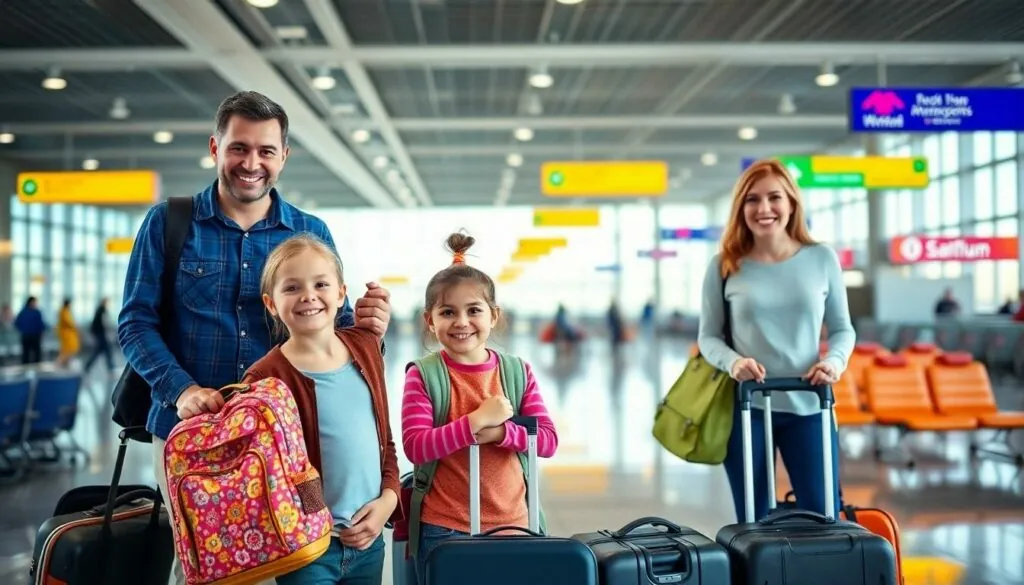Table of Contents
ToggleTraveling with kids can feel like preparing for a circus act—complete with clowns, acrobats, and the occasional meltdown. But fear not, savvy parents! With a little planning and some clever tricks up your sleeve, you can turn that chaotic journey into a smooth flight.
Planning Ahead
Preparation makes traveling with kids smoother. Consider the following strategies to ensure a stress-free journey.
Choosing the Right Flight
Select flights that coincide with your children’s sleep schedules. Nighttime flights often encourage kids to sleep, leading to a more pleasant journey for everyone. Look for direct routes whenever possible; they minimize layovers and transitions. If traveling with toddlers, opt for early morning flights, which usually have fewer delays. Parents should also review available in-flight entertainment options, as engaging activities keep kids entertained.
Booking Accommodations
Choose family-friendly accommodations with essential amenities. Look for hotels that offer cribs, kitchenettes, or laundry facilities for added convenience. Staying near attractions improves accessibility and keeps travel time short, which is crucial for young children. Research nearby restaurants with kid-friendly menus or dining options. Consider booking a larger room or suite to provide extra space for the family. Prioritizing child-friendly hotels can significantly enhance comfort during the trip.
Packing Essentials
Packing strategically ensures a smoother air travel experience with kids. Focus on the most critical items that provide comfort and keep children engaged during the journey.
Kid-Friendly Snacks
Snacks play a crucial role in maintaining energy and mood during flights. Include items such as granola bars, fruit pouches, and trail mix. These options are not only nutritious but also easy to pack. Consider packing a variety to cater to different preferences. Having snacks readily available helps avoid hunger-related meltdowns. Ensure that items comply with airline regulations to prevent complications during security checks.
Entertainment Options
Entertainment keeps kids occupied and distracts them from the travel process. Bring along tablets loaded with games, movies, and books. Activity books and coloring supplies also work well to engage younger travelers. Select items that are lightweight and portable to make packing easier. Parents should check that the electronic devices are charged and equipped with headphones for a quieter experience. Investing in portable devices can minimize boredom, ultimately making the journey more enjoyable for everyone.
At The Airport
Traveling with kids at the airport requires careful strategy. Parents should consider several factors to ensure a smoother experience.
Arriving Early
Arriving early helps alleviate stress before the flight. Setting aside extra time allows families to navigate check-in and security with ease. It offers moments for kids to explore the airport. Parents can visit play areas or grab a snack before boarding. Planning for potential delays ensures a more relaxed transition into travel mode.
Navigating Security
Navigating airport security can be daunting. To make the process easier, parents should prepare children for what to expect. Removing shoes, belts, and jackets will help kids understand the routine. Designating a parent to manage the items on the conveyor belt streamlines the procedure. Keeping snacks and electronic devices easily accessible minimizes fuss during inspections. Offering clear instructions to children promotes compliance and reduces anxiety.
On The Flight
Traveling with kids can present unique challenges once on board. Parents should manage their expectations to create a smoother experience for everyone.
Managing Expectations
Parents face the reality of limited space and potential delays in the air. Prepare children for the flight by discussing what they can expect, such as sitting still and following instructions. Activities will likely vary, so explain that waiting may occasionally occur. Not all flights will include entertainment options, which can necessitate extra planning for games and snacks. Additionally, staying calm during abrupt moments helps children feel secure and less anxious. Having a flexible attitude allows for adjustments based on a child’s mood or reactions, making the journey easier for everyone.
Keeping Kids Comfortable
Comfort plays a vital role in air travel with kids. Dress children in layered clothing, which accommodates temperature fluctuations on the plane. Bring along travel pillows and lightweight blankets for added coziness. Snacks should fit within easy reach; granola bars and fruit pouches help maintain energy levels. Providing entertainment options like tablets, activity books, and crayons keeps little ones occupied. Regular reminders to drink water assist in staying hydrated. If a child feels uneasy, calming techniques like deep breathing can help alleviate anxiety and promote relaxation during the flight.
Dealing with Challenges
Traveling with kids presents hurdles, but addressing these challenges can enhance the journey. Awareness and preparation are key.
Handling Delays
Delays happen, and managing them effectively reduces stress. Encourage children to be patient by bringing distractions like toys or books. Snacks play a vital role in maintaining their mood during unexpected waits. Keeping children informed about the situation fosters understanding and calmness. Providing screens with loaded games or shows also offers a welcomed diversion. Finally, a positive attitude helps create a more pleasant atmosphere despite the circumstances.
Addressing Fears
Many children experience anxiety regarding flying. Parents can mitigate fears by explaining the flying process openly and reassuringly. Sharing fun facts about planes and why they fly may spark excitement rather than fear. Role-playing scenarios about boarding and being on the plane promotes familiarity and confidence. Bringing comfort items, such as a favorite toy or blanket, can provide reassurance in unfamiliar environments. Consider practicing deep breathing techniques, which help reduce anxiety in children when they feel overwhelmed.
Conclusion
Traveling with kids doesn’t have to feel overwhelming. With thoughtful planning and the right strategies in place, families can enjoy smoother journeys and create lasting memories. By aligning travel schedules with children’s routines and packing essential comfort items, parents can significantly reduce stress.
Navigating airports and flights becomes easier with early arrivals and clear communication with children. Keeping kids engaged through entertainment and snacks ensures a more pleasant experience for everyone involved. Embracing flexibility and patience during unexpected challenges can turn potential meltdowns into teachable moments.
With these tips in hand, families are well-equipped to tackle air travel, making their adventures enjoyable and memorable.







